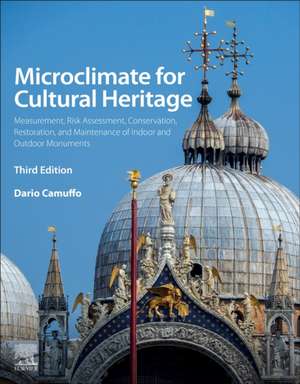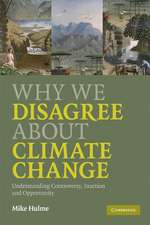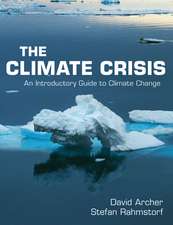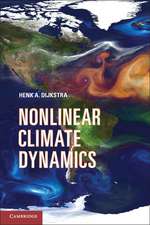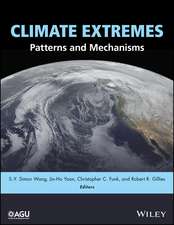Microclimate for Cultural Heritage: Measurement, Risk Assessment, Conservation, Restoration, and Maintenance of Indoor and Outdoor Monuments
Autor Dario Camuffoen Limba Engleză Paperback – 18 iun 2019
Sections covers applied theory, environmental issues and conservation, practical utilization, along with suggestions, examples, common issues and errors.
- Connects theory to practice with clear illustrations, useful examples, and case studies
- Covers practical issues, e.g. rising damp, moulds, and pests, indoor heating, thermal comfort, green lighting technology, performing field surveys
- Presents the latest standards for measuring cultural assets and their environment
- Discusses climate change and indoor - outdoor potential scenarios, including sea-level rise
| Toate formatele și edițiile | Preț | Express |
|---|---|---|
| Paperback (1) | 915.13 lei 36-50 zile | |
| ELSEVIER SCIENCE – 18 iun 2019 | 915.13 lei 36-50 zile | |
| Hardback (1) | 738.31 lei 36-50 zile | |
| ELSEVIER SCIENCE – 25 noi 2013 | 738.31 lei 36-50 zile |
Preț: 915.13 lei
Preț vechi: 1189.45 lei
-23% Nou
Puncte Express: 1373
Preț estimativ în valută:
175.13€ • 182.17$ • 144.58£
175.13€ • 182.17$ • 144.58£
Carte tipărită la comandă
Livrare economică 07-21 aprilie
Preluare comenzi: 021 569.72.76
Specificații
ISBN-13: 9780444641069
ISBN-10: 0444641068
Pagini: 582
Dimensiuni: 216 x 276 x 34 mm
Greutate: 1.33 kg
Ediția:3
Editura: ELSEVIER SCIENCE
ISBN-10: 0444641068
Pagini: 582
Dimensiuni: 216 x 276 x 34 mm
Greutate: 1.33 kg
Ediția:3
Editura: ELSEVIER SCIENCE
Public țintă
professionals, researchers and students in the field of conservation and restoration of monuments, architects, engineers, museum and church conservators, Cultural heritage conservationists, conservation scientists, restorers, environmental scientists, atmospheric scientists, chemists, physicistsCuprins
1. Microclimate and Atmospheric Variables
1.1 Microclimate
1.2 Air, Water Vapour, Perfect and Real Gases
1.3 The Internal Boundary Layer and the Viscous Layer
1.4 Coanda Effect
1.5 Atmospheric Variables and Parameters
2. Temperature: A Key Variable in Conservation
and Thermal Comfort
2.1 Temperature: One Variable, Four Popular
Definitions
2.2 Mechanisms of Temperature-Induced Deterioration
2.3 The Urban Heat Island
2.4 Temperature in a Building, a Room
2.5 Temperature in a Showcase
2.6 People’s Thermal Comfort and Discomfort
2.7 Is It Possible to Combine People’s Comfort, Conservation
Needs, and Sustainability?
2.8 Planning Air Temperature Monitoring to
Study Air–Surface Interactions and for Environmental
Diagnostics
3. Theoretical Grounds for Humidity
3.1 Partial Pressure of Water Vapour
3.2 Derivation of the Latent Heat
3.3 Mixing Ratio of Water Vapour and Dry Air
3.4 Specific Humidity
3.5 Absolute Humidity
3.6 Relative Humidity
3.7 Dew Point: The Temperature of Condensation
3.8 Frost Point: The Temperature of Freezing
3.9 Wet Bulb Temperature: The Temperature of Evaporation
3.10 The Psychrometric Chart
3.11 Humidity When It Rains or Snows
4. Consequences of the Maxwell–Boltzmann
Distribution
4.1 The Maxwell–Boltzmann Equation and the Distribution
of Molecules by Velocities
4.2 Thermal Emission of Bodies
4.3 The Arrhenius Equation
4.4 Saturation Pressure of Water Vapour in Air
4.5 Relative Humidity and Mutual Distance Between
H2O Molecules
4.6 The Liquid State and the Free H2O Molecules in It
4.7 The Raoult Law for Ideal Solutions
4.8 Ebullition and Freezing
4.9 An Additional Aspect of Relative Humidity
4.10 The Three Classes of Water Vapour
4.11 Conclusions
5. Physics of Drop Formation and Micropore
Condensation
5.1 How a Curved Water Meniscus Changes
the Equilibrium Vapour Tension
5.2 Derivation of the Kelvin Equation for Droplet
Formation and Micropore Condensation
5.3 The Formation of Droplets in the Atmosphere:
Homogeneous and Heterogeneous Nucleation
5.4 Bubbles
5.5 Micropore Condensation and Stone Weathering
5.6 Adsorption Isotherms
5.7 Freeze–Thaw Cycles
6. Humidity and Deterioration Mechanisms
6.1 Air–Surface Interactions and Environmental Diagnostics
6.2 The Equilibrium Moisture Content and Dimensional
Changes in Wood
6.3 Mechanisms of Humidity Degradation in Paper and
Parchment
6.4 Biological Habitat and Vacuum Cleaners
6.5 Molecular Layers of Water on the Surface of Metals
and Glass
6.6 Chemical Forms of Decay
6.7 A Complex Structure: The Organ Pipe
6.8 What Is the Best Microclimate for Conservation?
6.9 Keeping Constant Relative Humidity in Rooms and
Showcases
6.10 Condensation on Cold Surfaces
6.11 People as a Moisture Source
7. Atmospheric Water, Capillary Rise, and Stone
Weathering
7.1 Atmospheric Pollution, Acid Rain, Rainfall, and Crusts
7.2 Mechanisms of Penetration of Rainwater and Evaporation
7.3 Evaporation From Damp Monuments
7.4 Capillary Suction
7.5 The Equilibrium Vapour Tension Over a Solution
7.6 Climate Cycles, Sea Spray, and Salt Damage
7.7 Deliquescence–Crystallization Cycles
7.8 Some Common Errors That Should Be Avoided
8. Rising Damp Treatment and Prevention
8.1 Measures to Counteract Rising Damp
8.2 Removing Causes
8.3 Hiding Effects
8.4 Damp-Proof Course With Physical Barrier
8.5 Damp-Proof Course With Chemical Barrier
8.6 Increasing Wall Temperature
8.7 Ventilation Within the Wall
8.8 Ventilating Outside the Wall
8.9 Dehumidifying Plasters
8.10 Active Electro-Osmosis
8.11 Passive Electro-Osmosis
8.12 Parapsychological Devices
8.13 Drying Damp Murals
II
ATMOSPHERIC STABILITY,
POLLUTANT DISPERSION AND
SOILING OF PAINTINGS AND
MONUMENTS
9. Parameters to Describe Air Masses and
Vertical Air Motions
9.1 Equivalent Temperature
9.2 Adiabatic Gradients in Troposphere
9.3 Potential Temperature
9.4 Equivalent-Potential Temperature
9.5 Virtual Temperature
10. Atmospheric Stability and Pollutant Dispersion
10.1 Introduction
10.2 Vertical Temperature Gradients and Plume Behaviour
10.3 Effects Due to Topographic Horizontal Inhomogeneity
10.4 Urban Climate: Heat Island and Aerodynamic
Disturbance
10.5 Dispersion and Transportation of Pollutants
in a City
10.6 Wind Friction Near a Surface
10.7 Vertical Fluxes of Heat, Moisture and Momentum
10.8 Heat Balance at the Soil or the Monument Surface
10.9 Main Parameters Used in Measuring Atmospheric
Stability and Turbulence
10.10 Plume Dispersion
10.11 Stability Classes to Evaluate Atmospheric Stability
11. Dry Deposition of Airborne Particulate
Matter—Mechanisms and Effects
11.1 Introduction
11.2 Random Walk and Brownian Diffusivity
11.3 Brownian Deposition
11.4 Thermophoresis
11.5 Diffusiophoresis
11.6 Stefan Flow
11.7 Gravitational Settling
11.8 Electrophoresis
11.9 Photophoresis
11.10 Aerodynamic Deposition: Inertial Impaction and
Interception
11.11 Adhesion of Particles to Paintings or Other Surfaces
11.12 Vertical Distribution of Particles in Still Air and Their
Resuspension by Turbulence
11.13 How Soiling Develops
11.14 What Is the Most Appropriate Heating
and Air Conditioning System to Avoid Soiling?
11.15 Inappropriate Positioning of Paintings
11.16 Uplifting of Giant Particles and Wind Erosion
11.17 Kinetic Energy and Sand Blasting
III
RADIATION, LIGHT
AND COLOURS
12. Radiometric Aspects of Solar Radiation, Blackbody,
and Lamp Radiation
12.1 Radiation Emitted by Bodies and Effects
of the Absorbed Energy
12.2 Radiometric Temperature
12.3 Angular Distribution of Radiant Emission of Bodies
12.4 Attenuation of Light in the Atmosphere
12.5 Daily and Seasonal Cycles of Solar Radiation on
Monuments
12.6 Length of Shadow
12.7 Electric Lamps for Cultural Heritage
12.8 Problems Encountered in Exhibition Lighting
12.9 Optical Filters and Optical Fibres
12.10 Degradation of Works of Art Caused by Light
12.11 Photographic Flash Light
12.12 Phototrophic Organisms
1.1 Microclimate
1.2 Air, Water Vapour, Perfect and Real Gases
1.3 The Internal Boundary Layer and the Viscous Layer
1.4 Coanda Effect
1.5 Atmospheric Variables and Parameters
2. Temperature: A Key Variable in Conservation
and Thermal Comfort
2.1 Temperature: One Variable, Four Popular
Definitions
2.2 Mechanisms of Temperature-Induced Deterioration
2.3 The Urban Heat Island
2.4 Temperature in a Building, a Room
2.5 Temperature in a Showcase
2.6 People’s Thermal Comfort and Discomfort
2.7 Is It Possible to Combine People’s Comfort, Conservation
Needs, and Sustainability?
2.8 Planning Air Temperature Monitoring to
Study Air–Surface Interactions and for Environmental
Diagnostics
3. Theoretical Grounds for Humidity
3.1 Partial Pressure of Water Vapour
3.2 Derivation of the Latent Heat
3.3 Mixing Ratio of Water Vapour and Dry Air
3.4 Specific Humidity
3.5 Absolute Humidity
3.6 Relative Humidity
3.7 Dew Point: The Temperature of Condensation
3.8 Frost Point: The Temperature of Freezing
3.9 Wet Bulb Temperature: The Temperature of Evaporation
3.10 The Psychrometric Chart
3.11 Humidity When It Rains or Snows
4. Consequences of the Maxwell–Boltzmann
Distribution
4.1 The Maxwell–Boltzmann Equation and the Distribution
of Molecules by Velocities
4.2 Thermal Emission of Bodies
4.3 The Arrhenius Equation
4.4 Saturation Pressure of Water Vapour in Air
4.5 Relative Humidity and Mutual Distance Between
H2O Molecules
4.6 The Liquid State and the Free H2O Molecules in It
4.7 The Raoult Law for Ideal Solutions
4.8 Ebullition and Freezing
4.9 An Additional Aspect of Relative Humidity
4.10 The Three Classes of Water Vapour
4.11 Conclusions
5. Physics of Drop Formation and Micropore
Condensation
5.1 How a Curved Water Meniscus Changes
the Equilibrium Vapour Tension
5.2 Derivation of the Kelvin Equation for Droplet
Formation and Micropore Condensation
5.3 The Formation of Droplets in the Atmosphere:
Homogeneous and Heterogeneous Nucleation
5.4 Bubbles
5.5 Micropore Condensation and Stone Weathering
5.6 Adsorption Isotherms
5.7 Freeze–Thaw Cycles
6. Humidity and Deterioration Mechanisms
6.1 Air–Surface Interactions and Environmental Diagnostics
6.2 The Equilibrium Moisture Content and Dimensional
Changes in Wood
6.3 Mechanisms of Humidity Degradation in Paper and
Parchment
6.4 Biological Habitat and Vacuum Cleaners
6.5 Molecular Layers of Water on the Surface of Metals
and Glass
6.6 Chemical Forms of Decay
6.7 A Complex Structure: The Organ Pipe
6.8 What Is the Best Microclimate for Conservation?
6.9 Keeping Constant Relative Humidity in Rooms and
Showcases
6.10 Condensation on Cold Surfaces
6.11 People as a Moisture Source
7. Atmospheric Water, Capillary Rise, and Stone
Weathering
7.1 Atmospheric Pollution, Acid Rain, Rainfall, and Crusts
7.2 Mechanisms of Penetration of Rainwater and Evaporation
7.3 Evaporation From Damp Monuments
7.4 Capillary Suction
7.5 The Equilibrium Vapour Tension Over a Solution
7.6 Climate Cycles, Sea Spray, and Salt Damage
7.7 Deliquescence–Crystallization Cycles
7.8 Some Common Errors That Should Be Avoided
8. Rising Damp Treatment and Prevention
8.1 Measures to Counteract Rising Damp
8.2 Removing Causes
8.3 Hiding Effects
8.4 Damp-Proof Course With Physical Barrier
8.5 Damp-Proof Course With Chemical Barrier
8.6 Increasing Wall Temperature
8.7 Ventilation Within the Wall
8.8 Ventilating Outside the Wall
8.9 Dehumidifying Plasters
8.10 Active Electro-Osmosis
8.11 Passive Electro-Osmosis
8.12 Parapsychological Devices
8.13 Drying Damp Murals
II
ATMOSPHERIC STABILITY,
POLLUTANT DISPERSION AND
SOILING OF PAINTINGS AND
MONUMENTS
9. Parameters to Describe Air Masses and
Vertical Air Motions
9.1 Equivalent Temperature
9.2 Adiabatic Gradients in Troposphere
9.3 Potential Temperature
9.4 Equivalent-Potential Temperature
9.5 Virtual Temperature
10. Atmospheric Stability and Pollutant Dispersion
10.1 Introduction
10.2 Vertical Temperature Gradients and Plume Behaviour
10.3 Effects Due to Topographic Horizontal Inhomogeneity
10.4 Urban Climate: Heat Island and Aerodynamic
Disturbance
10.5 Dispersion and Transportation of Pollutants
in a City
10.6 Wind Friction Near a Surface
10.7 Vertical Fluxes of Heat, Moisture and Momentum
10.8 Heat Balance at the Soil or the Monument Surface
10.9 Main Parameters Used in Measuring Atmospheric
Stability and Turbulence
10.10 Plume Dispersion
10.11 Stability Classes to Evaluate Atmospheric Stability
11. Dry Deposition of Airborne Particulate
Matter—Mechanisms and Effects
11.1 Introduction
11.2 Random Walk and Brownian Diffusivity
11.3 Brownian Deposition
11.4 Thermophoresis
11.5 Diffusiophoresis
11.6 Stefan Flow
11.7 Gravitational Settling
11.8 Electrophoresis
11.9 Photophoresis
11.10 Aerodynamic Deposition: Inertial Impaction and
Interception
11.11 Adhesion of Particles to Paintings or Other Surfaces
11.12 Vertical Distribution of Particles in Still Air and Their
Resuspension by Turbulence
11.13 How Soiling Develops
11.14 What Is the Most Appropriate Heating
and Air Conditioning System to Avoid Soiling?
11.15 Inappropriate Positioning of Paintings
11.16 Uplifting of Giant Particles and Wind Erosion
11.17 Kinetic Energy and Sand Blasting
III
RADIATION, LIGHT
AND COLOURS
12. Radiometric Aspects of Solar Radiation, Blackbody,
and Lamp Radiation
12.1 Radiation Emitted by Bodies and Effects
of the Absorbed Energy
12.2 Radiometric Temperature
12.3 Angular Distribution of Radiant Emission of Bodies
12.4 Attenuation of Light in the Atmosphere
12.5 Daily and Seasonal Cycles of Solar Radiation on
Monuments
12.6 Length of Shadow
12.7 Electric Lamps for Cultural Heritage
12.8 Problems Encountered in Exhibition Lighting
12.9 Optical Filters and Optical Fibres
12.10 Degradation of Works of Art Caused by Light
12.11 Photographic Flash Light
12.12 Phototrophic Organisms
